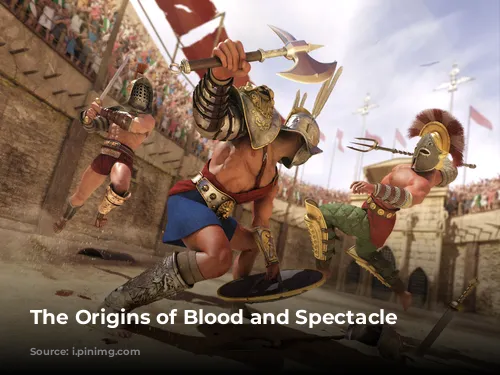The Brutus family, a powerhouse in the early days of the Roman Republic, left a lasting legacy. Their influence was so strong that even their funerals became a spectacle for the masses. This family, whose member, Lucius Junius Brutus, helped establish the Republic, continued to play a crucial role in Roman politics for centuries.
In the year 264 B.C., Brutus Pera, a prominent member of this dynasty, passed away. His sons wanted to honor their father with a lavish tribute, a munus, a public event featuring food and drink. But they wanted more – they desired something truly memorable, a bloody fight to the death.
From Funeral Rites to Public Entertainment
This decision by the Brutus brothers ignited a tradition that would last for centuries, a tradition of gladiatorial combat in the Eternal City. Today, we think of gladiatorial games as synonymous with Roman society. However, the truth is, this barbaric practice was borrowed from elsewhere.
The gladiator fight at Brutus Pera’s funeral involved six warriors, dressed in the garb of the Thracians, a people from present-day Bulgaria. The six unfortunate souls, likely purchased as slaves, fought each other until only one survivor remained. Their blood spilled, the plebians of Rome were given a glimpse of the brutality they would come to crave.
These gladiatorial fights at funerals were a form of human sacrifice, a practice common in the ancient world. We see a similar example in Homer’s Iliad where the Greek hero Achilles sacrifices prisoners of war at his lover’s funeral.
However, gladiatorial combat on the Italian peninsula was popularized by the Campanians, descendants of Greek settlers, a century before Brutus Pera’s death. These fights were not exclusively linked to funerals. The Campanians, drawing inspiration from their ancestors, initiated this practice to celebrate a victory over their rivals, the Samnites. They forced slaves, clad in captured Samnite armor, to fight until death.
The Rise of Spectacle
The inclusion of gladiatorial fights at funerals became increasingly common in Rome during the late centuries B.C. The number of gladiators participating in each munus also swelled. In 216 B.C., over 40 gladiators battled to the death at the funeral of Marcus Aemilius Lepidus. Less than 40 years later, in 183 B.C., the funeral of Publius Licinius featured 120 gladiators, with the fights lasting three days. These spectacles were a display of the deceased family’s wealth and power.
Initially, gladiatorial fights were held in the Forum Boarium, Rome’s cattle market, with minimal seating for the audience. But as the popularity of these fights grew, they were moved to the larger Forum Romanum, where temporary wooden stands were built to accommodate the increasing crowds.
The Evolution of the Gladiator
The gladiators themselves underwent a transformation. Initially, they were slaves, armed with basic weaponry and no armor, forced to fight with minimal training. Over time, organizers started providing them with armor similar to that worn by Roman soldiers, including chainmail. However, this armor prolonged the fights, contradicting the goal of spectacle and sacrifice. As a result, the armor was simplified, leaving gladiators with iconic greaves, helmets, and shields. With minimal protection for their chests, fatal wounds became more likely, guaranteeing a bloody and brutal spectacle.
Gladiators and Politics
By the first century B.C., munera had evolved into a political tool, although still ostensibly linked to funeral rites. Any Roman dignitary aiming for political office would stage lavish funeral games to win public favor, often with flimsy excuses. Julius Caesar, eager to advance his political career in 65 B.C., held a munus for his father, who had been dead for 20 years. This event featured 640 gladiators, clad in armor made of solid silver. Nineteen years later, Caesar repeated this grand display, this time for his daughter, who had been dead for a decade. To add to the spectacle, Caesar included not just slave gladiators, but also a fight between two Roman aristocrats who had supported Caesar’s political rival, Pompey.
The End of Private Munera, but Not the Bloodshed
Within a year of these games, Caesar was assassinated by members of the Roman Senate, plunging Rome into civil war. During the Imperial period, emperors prohibited private citizens from holding munera without their permission. This didn’t end gladiatorial combat, but transformed it into state-sponsored spectacles designed to honor the emperor and bolster his popularity with the masses, who remained insatiable for bread, circuses, and bloodshed.
